O. Reg. 32/94: VEHICLE CONFIGURATIONS, Highway Traffic Act, R.S.O. 1990, c. H.8
Highway Traffic Act
Code de la route
ONTARIO REGULATION 32/94
Amended to O. Reg. 413/05
VEHICLE CONFIGURATIONS
Note: This Regulation was revoked on June 28, 2005. See: O. Reg. 413/05, s. 38.
This Regulation is made in English only.
1. In this Regulation,
“axle spread” means the longitudinal distance between the centres of the foremost and rearmost axles of an axle unit;
“bed length” means the external measurement of a trailer from the front of its cargo carrying space to the rear of its cargo carrying space, but excluding any portion of auxiliary equipment or machinery that extends beyond the front of the trailer and that is not designed for the transportation of goods;
“effective overhang” means the longitudinal distance from the turn centre of the trailer to its rearmost point, including any load;
“fifth wheel assembly” means a plate-type coupling device comprised of a kingpin, locking jaws and plates whose lower half is mounted on the rear portion of a vehicle frame or the frame of a trailer converter dolly and whose upper half is fastened to the underside of the forward portion of a semi-trailer for the purpose of supporting and towing the semi-trailer;
“full trailer” means a trailer designed so that its own weight and any load are carried on its own axles and includes a combination consisting of a semi-trailer and a trailer converter dolly;
“inter-axle spacing” means the longitudinal distance separating two consecutive axle units within a vehicle or combination of vehicles, measured from the centre of the rearmost axle of the foremost axle unit to the centre of the foremost axle of the other axle unit;
“liftable axle” means an assembly of two or more wheels whose centres are in one transverse vertical plane that is equipped with a device for altering (other than by longitudinal movement of the assembly only) the weight transmitted to the highway surface and that may be able to lift its tires from contact with that surface;
“self-steering axle” means an assembly of two or more wheels whose centres are in one transverse vertical plane and whose wheels can articulate in response to forces generated between the tires and the road or through mechanisms and linkages that operate independently of the driver;
“swing radius” means the greatest horizontal distance from the vertical axis through the centre of the kingpin to any point on the semi-trailer ahead of the kingpin, including load and any extension to the length caused by auxiliary equipment or machinery;
“tandem axle” means a “dual axle” as defined in Part VIII that does not include a liftable axle or a self-steering axle and that has the same number of tires on each wheel;
“track width” means the width of an axle across the outside faces of the tires measured at any point above the lowest point of the rim;
“tridem axle” means a “triple axle” as defined in Part VIII that does not include a liftable axle or a self-steering axle and that has the same number of tires on each wheel;
“turn centre” means the geometric centre of the axle unit on a semi- trailer or of the rear axle unit on a tractor or a full trailer;
“wheelbase” means the longitudinal distance,
(a) from the centre of the kingpin to the turn centre in the case of a semi-trailer,
(b) from the centre of the front axle to the turn centre in the case of a tractor,
(c) from the centre of articulation of the turntable to the turn centre in the case of a full trailer. O. Reg. 32/94, s. 1; O. Reg. 600/98, s. 1.
2. The rearmost trailer in a combination of vehicles described in this Regulation shall be equipped with a rear impact guard if the trailer is built after July 14, 1993 and,
(a) it has an axle unit that can slide or is fixed so that the rear of the rearmost tire is more than 0.3 metres in front of the rear of the trailer; and
(b) its rear structure is more than 0.56 metres above the ground when the trailer is unladen on a level surface. O. Reg. 32/94, s. 2.
3. (1) A rear impact guard on a trailer, as shown in Figure 1, shall consist of a single horizontal beam that is rigidly attached to the trailer and that,
(a) extends within 0.1 metres of each side of the trailer;
(b) is not more than 0.3 metres in front of the rear of the trailer and is as close to its rear as practicable; and
(c) is not more than 0.56 metres above the ground when the trailer is unladen on a level surface. O. Reg. 600/98, s. 2.
(2) A rear impact guard on a trailer, as shown in Figure 1, that is manufactured after January 26, 1998 shall meet the standards for such a guard under United States Federal Motor Vehicle Safety Standard 224 that became effective on January 26, 1998, or a corresponding standard, if any, under the Motor Vehicle Safety Act (Canada). O. Reg. 600/98, s. 2.
Figure 1/ Rear Impact Guard Requirements
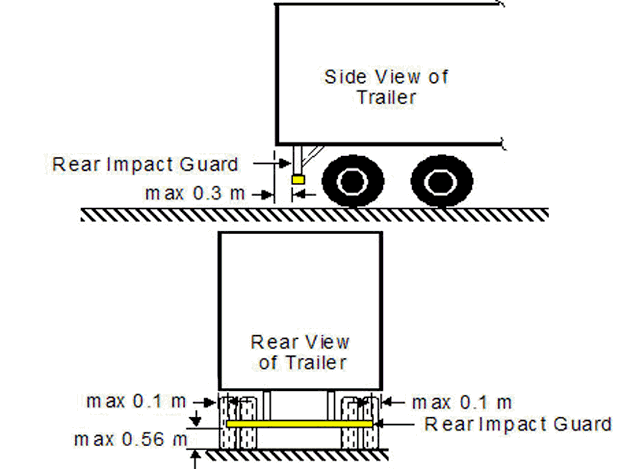
O. Reg. 32/94, s. 3.
4. Revoked: O. Reg. 306/00, s. 1.
Figure 2/ Conspicuity Markings
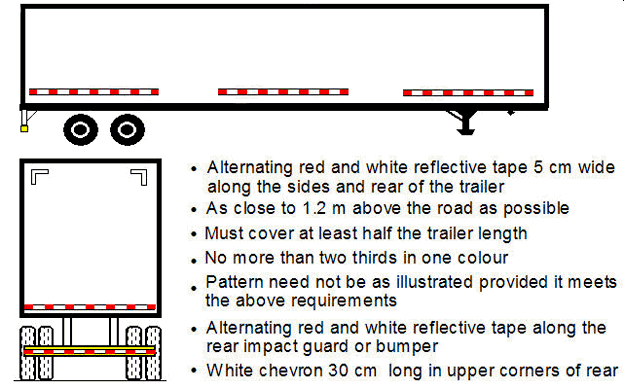
O. Reg. 32/94, s. 4.
5. All wheels on all vehicles and trailer converter dollies described in this Regulation and manufactured after October 19, 1994 shall be fitted with a system of automatic brake adjustment and brake adjustment indicators in accordance with United States Federal Motor Vehicle Safety Standard 121 S5.1.8 or S5.2.2, or with the corresponding requirements in Canadian Motor Vehicle Safety Standard 121 that became effective on May 31, 1996. O. Reg. 600/98, s. 4.
Tractor and Semi-trailer
6. A combination of vehicles composed of a tractor and a semi- trailer, as shown in Figure 3, may be operated on a highway if the requirements of sections 7, 8 and 9 are met.
Figure 3/ Tractor and Semi-trailer
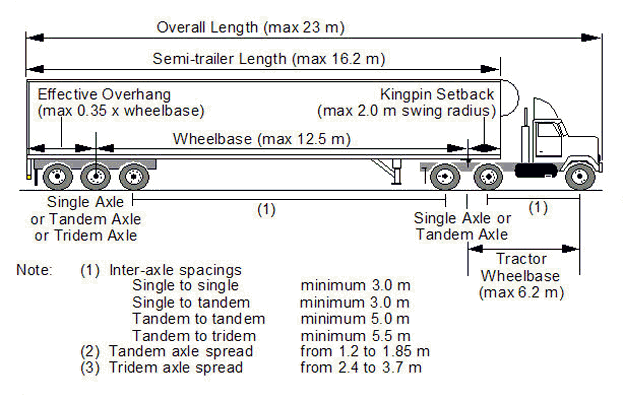
O. Reg. 32/94, s. 6.
7. (1) The tractor shall have as its front axle one axle equipped with single tires and as its drive axle one axle or a tandem axle that has an axle spread of 1.2 to 1.85 metres. O. Reg. 32/94, s. 7 (1).
(2) The tractor’s inter-axle spacing from its front axle shall not be less than three metres and its wheelbase shall not be greater than 6.2 metres. O. Reg. 32/94, s. 7 (2).
(3) The tractor shall not be equipped with a liftable axle or a self-steering axle, whether raised, lowered or rendered inoperative. O. Reg. 32/94, s. 7 (3).
8. (1) The semi-trailer shall have one axle, a tandem axle that has an axle spread of 1.2 to 1.85 metres or a tridem axle that has an axle spread of 2.4 to 3.7 metres and, if the semi-trailer’s width exceeds 2.5 metres, all of its axles shall have a track width of at least 2.5 metres. O. Reg. 32/94, s. 8 (1).
(2) The swing radius of the semi-trailer shall not be greater than two metres, its wheelbase not greater than 12.5 metres and its effective overhang, including load, not greater than 35 per cent of its wheelbase. O. Reg. 32/94, s. 8 (2).
(3) The semi-trailer shall not be equipped with a liftable axle or a self-steering axle, whether raised, lowered or rendered inoperative. O. Reg. 32/94, s. 8 (3).
(4) Revoked: O. Reg. 306/00, s. 2.
9. The combination of vehicles, including load, shall not exceed twenty-three metres in length and the weight on any tire in the combination shall not exceed 3,000 kilograms. O. Reg. 32/94, s. 9.
A-train Double
10. (1) An A-train double, as shown in Figure 4, shall be composed of a tractor, a semi-trailer and,
(a) a trailer converter dolly that is towed from a single hitch on the centre line of the semi-trailer and another semi-trailer; or
(b) a full trailer attached to the semi-trailer as if a trailer converter dolly were used and towed from a single hitch on the centre line of the semi-trailer. O. Reg. 32/94, s. 10 (1).
(2) An A-train double may be operated on a highway if the requirements of sections 11 to 14 are met. O. Reg. 32/94, s. 10 (2).
Figure 4/ A-Train Double
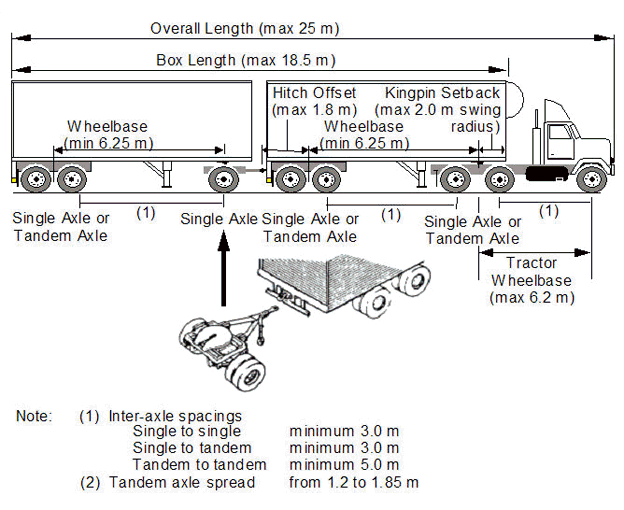
O. Reg. 600/98, s. 5.
11. The tractor of an A-train double shall meet the requirements set out in section 7. O. Reg. 32/94, s. 11.
12. (1) The foremost semi-trailer shall have one axle or a tandem axle that has an axle spread of 1.2 to 1.85 metres and, if the semi-trailer’s width exceeds 2.5 metres, all of its axles shall have a track width of at least 2.5 metres. O. Reg. 32/94, s. 12 (1).
(2) The inter-axle spacing from the tractor drive axle unit shall be at least,
(a) three metres, if one of the axle units has only one axle;
(b) five metres, if both axle units are tandem axles. O. Reg. 32/94, s. 12 (2).
(3) The swing radius of the foremost semi-trailer shall not be greater than two metres, its wheelbase shall not be less than 6.25 metres and its hitch offset shall not be greater than 1.8 metres. O. Reg. 600/98, s. 6.
(4) The foremost semi-trailer shall not be equipped with a liftable axle or a self-steering axle, whether raised, lowered or rendered inoperative. O. Reg. 32/94, s. 12 (4).
(5) In this section,
“hitch offset” means the longitudinal distance from the turn centre of the foremost semi-trailer to the articulation point of the hitch used to tow the rearmost trailer. O. Reg. 32/94, s. 12 (5).
13. (1) The rearmost trailer shall have one axle at the front and one axle or a tandem axle that has an axle spread of 1.2 to 1.85 metres at the rear and, if the trailer’s width exceeds 2.5 metres, all of its axles shall have a track width of at least 2.5 metres. O. Reg. 32/94, s. 13 (1).
(2) The wheelbase of the rearmost trailer shall not be less than 6.25 metres and the inter-axle spacing from its foremost axle unit shall not be less than three metres. O. Reg. 600/98, s. 7 (1).
(3) The rearmost trailer shall not be equipped with a liftable axle or a self-steering axle, whether raised, lowered or rendered inoperative. O. Reg. 32/94, s. 13 (3).
(4) The gross vehicle weight of the rearmost trailer shall not exceed the combined weight of the tractor drive axle unit and the foremost semi-trailer axle unit. O. Reg. 600/98, s. 7 (2).
14. (1) The box length of an A-train double shall not exceed 18.5 metres and the weight on any of its tires shall not exceed 3,000 kilograms. O. Reg. 32/94, s. 14 (1).
(2) Revoked: O. Reg. 306/00, s. 3.
(3) The gross vehicle weight of an A-train double shall be calculated as set out in the Act, except that, for the purposes of that calculation, the front axle load is the lesser of the actual front axle load and 5,499 kilograms and the gross vehicle weight shall not exceed,
(a) 41,900 kilograms, if there are five axles;
(b) 49,800 kilograms, if there are six axles;
(c) 53,500 kilograms, if there are seven or eight fixed axles. O. Reg. 32/94, s. 14 (3); O. Reg. 600/98, s. 8.
B-train Double
15. (1) A B-train double, as shown in Figure 5, shall be composed of a tractor and two semi-trailers, the rearmost of which is attached by a fifth wheel assembly whose lower half is mounted on the rear of the foremost semi-trailer. O. Reg. 32/94, s. 15 (1).
(2) A B-train double may be operated on a highway if the requirements of sections 16 to 19 are met. O. Reg. 32/94, s. 15 (2).
Figure 5/ B-Train Double
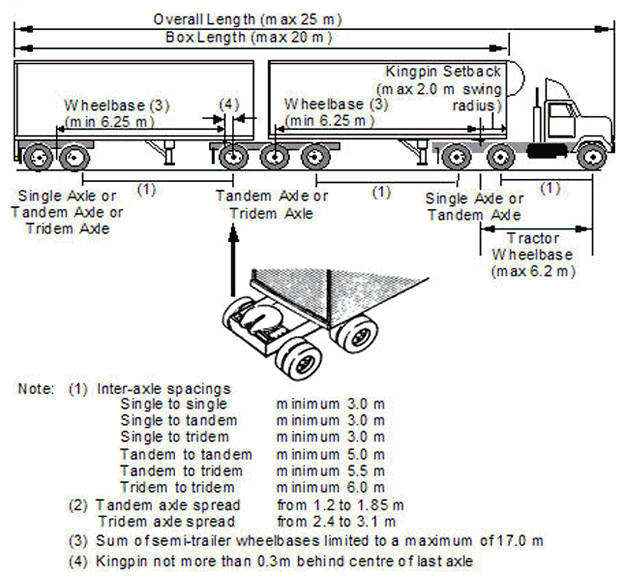
O. Reg. 600/98, s. 9.
16. The tractor shall meet the requirements set out in section 7. O. Reg. 32/94, s. 16.
17. (1) The foremost semi-trailer shall have a tandem axle that has an axle spread of 1.2 to 1.85 metres or a tridem axle that has an axle spread of 2.4 to 3.1 metres and all of its axles shall have a track width of at least 2.5 metres. O. Reg. 32/94, s. 17 (1).
(2) The swing radius of the foremost semi-trailer shall not be greater than two metres and its wheelbase shall not be less than 6.25 metres. O. Reg. 600/98, s. 10 (1).
(3) The inter-axle spacing from the tractor drive axle unit shall be at least,
(a) three metres, if one of the axle units has only one axle;
(b) five metres, if both axle units are tandem axles;
(c) 5.5 metres, if the axle units are a tandem axle and a tridem axle. O. Reg. 32/94, s. 17 (3).
(4) The foremost semi-trailer shall not be equipped with a liftable axle or a self-steering axle, whether raised, lowered or rendered inoperative. O. Reg. 32/94, s. 17 (4).
(5) The fifth wheel shall be mounted so that the kingpin of the rearmost trailer, when attached, is no more than 0.3 metres behind the centre of the rearmost axle of the foremost semi-trailer. O. Reg. 600/98, s. 10 (2).
18. (1) The rearmost semi-trailer shall have,
(a) one axle;
(b) a tandem axle that has an axle spread of 1.2 to 1.85 metres; or
(c) a tridem axle that has an axle spread of 2.4 to 3.1 metres, if there are no more than nine fixed axles in the combination of vehicles. O. Reg. 600/98, s. 11 (1).
(1.1) Every axle of the rearmost semi-trailer shall have a track width of at least 2.5 metres. O. Reg. 600/98, s. 11 (1).
(2) The rearmost semi-trailer shall have a wheelbase that is not less than 6.25 metres. O. Reg. 32/94, s. 18 (2).
(3) The inter-axle spacing from the foremost semi-trailer axle unit shall be at least,
(a) three metres, if one of the axle units has only one axle;
(b) five metres, if both axle units are tandem axles;
(c) 5.5 metres, if the axle units are a tandem axle and a tridem axle;
(d) six metres, if both axle units are tridem axles. O. Reg. 32/94, s. 18 (3); O. Reg. 600/98, s. 11 (2).
(4) The rearmost semi-trailer shall not be equipped with a liftable axle or a self-steering axle, whether raised, lowered or rendered inoperative. O. Reg. 32/94, s. 18 (4).
19. (1) The box length of a B-train double shall not exceed twenty metres and the weight on any of its tires shall not exceed 3,000 kilograms. O. Reg. 32/94, s. 19 (1).
(2) The sum of the wheelbases of a B-train double’s semi-trailers shall not exceed seventeen metres. O. Reg. 32/94, s. 19 (2).
(3) Revoked: O. Reg. 306/00, s. 4.
(4) The gross vehicle weight of a B-train double shall be calculated as set out in the Act, except that, for the purposes of the calculation, Table A shall be used instead of Table 22 of Regulation 597 of the Revised Regulations of Ontario, 1990 if there are seven axles and Table B shall be used instead of Table 29 of that Regulation if there are eight or nine fixed axles. O. Reg. 600/98, s. 12 (1).
TABLE A
ALLOWABLE GROSS WEIGHT ON A B-TRAIN WITH 7 AXLES
Base Length (metres) |
Front Axle Weight (kilograms) | |
5000 or less |
5001 to and including 6000 | |
Less than 17.0 |
5590 |
56500 |
17.00 to less than 17.25 |
56300 |
56600 |
17.25 to less than 17.50 |
56700 |
57000 |
17.50 to less than 17.75 |
57100 |
57400 |
17.75 to less than 18.00 |
57500 |
57800 |
18.00 to less than 18.25 |
57900 |
58200 |
18.25 to less than 18.50 |
58400 |
58600 |
18.50 to less than 18.75 |
58800 |
59000 |
18.75 to less than 19.00 |
59300 |
59500 |
19.00 to less than 19.25 |
59700 |
59900 |
19.25 and over |
60100 |
60300 |
O. Reg. 32/94, s. 19, Table A.
TABLE B
ALLOWABLE GROSS WEIGHT ON A B-TRAIN WITH 8 OR 9 FIXED AXLES
Base Length (metres) |
Front Axle Weight (kilograms) | |
5000 or less |
5001 to and including 6000 | |
Less than 19.00 |
60600 |
61000 |
19.00 to less than 19.25 |
61100 |
61400 |
19.25 to less than 19.40 |
61500 |
61800 |
19.40 to less than 19.75 |
61700 |
62500 |
19.75 to less than 20.00 |
62100 |
62900 |
20.00 to less than 20.25 |
62300 |
63100 |
20.25 to less than 20.50 |
62600 |
63300 |
20.50 to less than 20.75 |
62900 |
63500 |
20.75 to less than 21.00 |
63100 |
63500 |
21.00 to less than 21.25 |
63300 |
63500 |
21.25 and over |
63500 |
63500 |
O. Reg. 32/94, s. 19, Table B; O. Reg. 600/98, s. 12 (2).
C-train Double
20. (1) A C-train double, as shown in Figure 6, shall be composed of a tractor and two semi-trailers the second of which is attached to the first by a trailer converter dolly with a frame rigid in the horizontal plane that is towed from two hitches located in a horizontal transverse line on the foremost semi-trailer that preclude any rotation in the horizontal plane about the hitch points. O. Reg. 32/94, s. 20 (1).
(2) A C-train double may be operated on a highway if the requirements of sections 21 to 25 are met. O. Reg. 32/94, s. 20 (2).
Figure 6/ C-Train Double
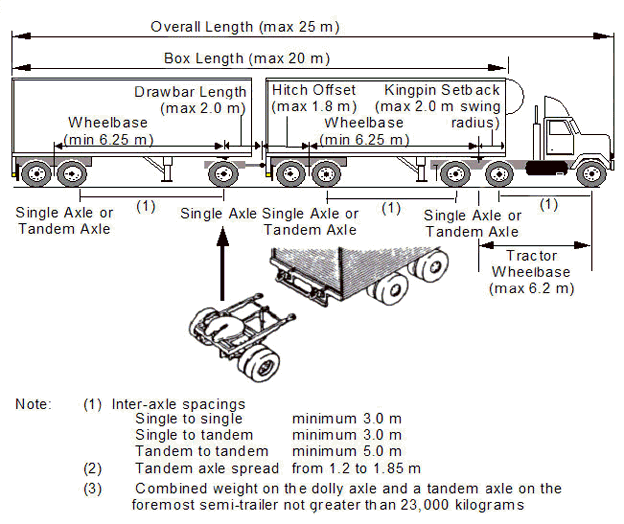
O. Reg. 600/98, s. 13.
21. The tractor of a C-train double shall meet the requirements set out in section 7. O. Reg. 32/94, s. 21.
22. The foremost semi-trailer shall meet the requirements set out in subsections 12 (1), (2), (3) and (4) and, in addition, it shall have a hitch that meets the requirements of section 904 of the Motor Vehicle Safety Act (Canada). O. Reg. 32/94, s. 22.
23. (1) The trailer converter dolly referred to in subsection 20 (1) shall be equipped with a drawbar that does not exceed two metres in length and the trailer converter dolly shall meet the requirements of section 903 of the Motor Vehicle Safety Act (Canada). O. Reg. 32/94, s. 23 (1).
(2) The track width of the trailer converter dolly shall be at least 2.5 metres if the width of the rearmost semi-trailer exceeds 2.5 metres. O. Reg. 32/94, s. 23 (2).
(3) In this section,
“drawbar” means a towing structure that is connected to the chassis frame of the trailer converter dolly that includes an eye or equivalent device for coupling to a trailer hitch. O. Reg. 32/94, s. 23 (3).
24. (1) The rearmost semi-trailer shall have one axle or a tandem axle that has an axle spread of 1.2 to 1.85 metres and, if the width of the semi-trailer exceeds 2.5 metres, all of its axles shall have a track width of at least 2.5 metres. O. Reg. 32/94, s. 24 (1).
(2) The rearmost semi-trailer shall have a wheelbase of at least 6.25 metres. O. Reg. 600/98, s. 14 (1).
(3) The combined weight of the trailer converter dolly axle and the rearmost semi-trailer axle unit shall not exceed the combined weight of the tractor drive axle unit and the foremost semi-trailer axle unit. O. Reg. 600/98, s. 14 (2).
(4) The rearmost semi-trailer shall not be equipped with a liftable axle or a self-steering axle, whether raised, lowered or rendered inoperative. O. Reg. 32/94, s. 24 (4).
25. (1) The box length of a C-train double shall not exceed twenty metres. O. Reg. 32/94, s. 25 (1).
(2) The weight on any tire of a C-train double shall not exceed 3,000 kilograms and the combined weight on a tandem axle on the foremost semi-trailer and on the trailer converter dolly axle shall not exceed 23,000 kilograms. O. Reg. 32/94, s. 25 (2).
(3) Revoked: O. Reg. 306/00, s. 5.
(4) The gross vehicle weight of a C-train double shall be calculated as set out in the Act, except that, for the purposes of that calculation, the front axle load is the lesser of the actual front axle load and 5,499 kilograms and the gross vehicle weight shall not exceed,
(a) 41,900 kilograms, if there are five axles;
(b) 49,800 kilograms, if there are six axles;
(c) 54,600 kilograms, if there are seven axles;
(d) 58,500 kilograms, if there are eight fixed axles. O. Reg. 32/94, s. 25 (4); O. Reg. 600/98, s. 15.
Buses
26. (1) A bus, as shown in Figure 7, commonly known as an intercity motor coach, may be operated on a highway if it meets the requirements of this section. O. Reg. 32/94, s. 26 (1).
(2) The bus shall be equipped with motive power mounted to the rear of the front axle, air-ride or torsion-bar suspension, reclining seats and a baggage area that is separated from the passenger cabin. O. Reg. 32/94, s. 26 (2).
(3) The total length of the bus, including bumpers, shall not exceed fourteen metres. O. Reg. 32/94, s. 26 (3).
(4) The bus shall have three axles and any tandem axle or two axle group shall have an axle spread of 1.2 to 1.85 metres. O. Reg. 32/94, s. 26 (4).
(5) The longitudinal distance between the geometric centre of a dual axle or a two axle group and the rear of the bus, including bumpers, shall not exceed four metres. O. Reg. 32/94, s. 26 (5).
(6) Any two axle group shall distribute the load it carries between the axles in a ratio corresponding to the number of tires on each axle.
Figure 7/ Intercity Motor Coach

O. Reg. 32/94, s. 26 (6).
Liftable Axles on a Double Trailer Combination
27. (1) Despite subsections 12 (4), 13 (3), 17 (4) and 18 (4), section 22 and subsection 24 (4), both of the trailers on an A-train double, as shown in Figure 8, both of the trailers on a B-train double, as shown in Figure 9, and both of the trailers on a C-train double, as shown in Figure 10, may be equipped with one liftable axle if,
(a) the bed length of any trailer does not exceed 8.7 metres;
(b) the box length does not exceed 18.5 metres;
(c) the A-train double or C-train double has eight fixed axles, not including the liftable axles;
(d) the B-train double has eight or nine fixed axles, not including the liftable axles;
(e) the liftable axles are in front of the rearmost fixed axle unit on the trailer when the vehicle is being operated;
(f) the liftable axles are raised when the vehicle is operated on a highway;
(g) no trailer is equipped with a self-steering axle, unless the self-steering axle is also a liftable axle; and
(h) every vehicle included in the A-train double, B-train double or C-train double, including a trailer converter dolly, meets all other requirements in the Act or this Regulation which would otherwise be applicable if the trailer did not have liftable axles. O. Reg. 311/99, s. 1.
(2) The liftable axles shall be excluded from the calculation of allowable gross weight as set out in the Act and any regulations.
Figure 8/ A-Train Double
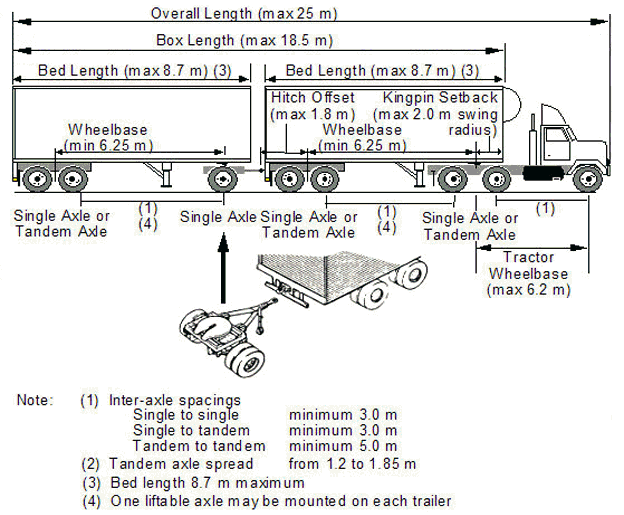
Figure 9/ B-Train Double
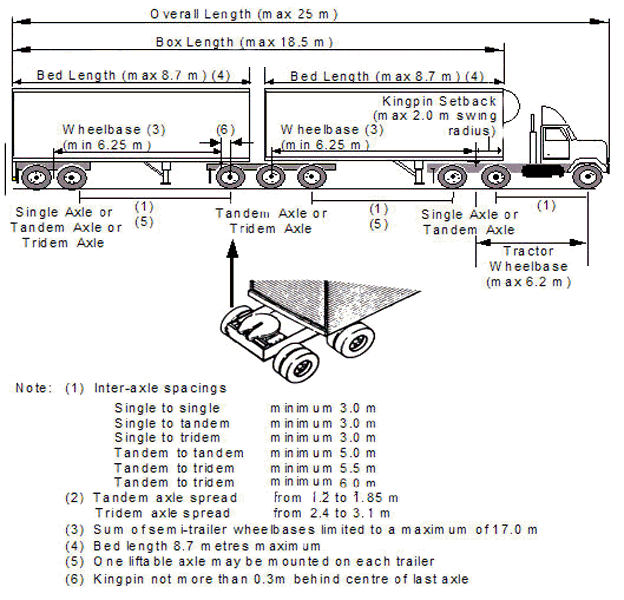
Figure 10/ C-Train Double
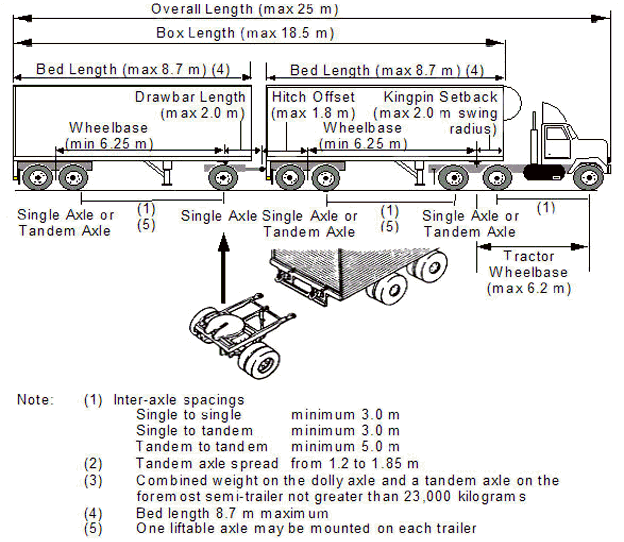
O. Reg. 311/99, s. 1.